Quite possible to modify this program according to your wishes!!!
Day – 1 : Arrive in Ulan Bator city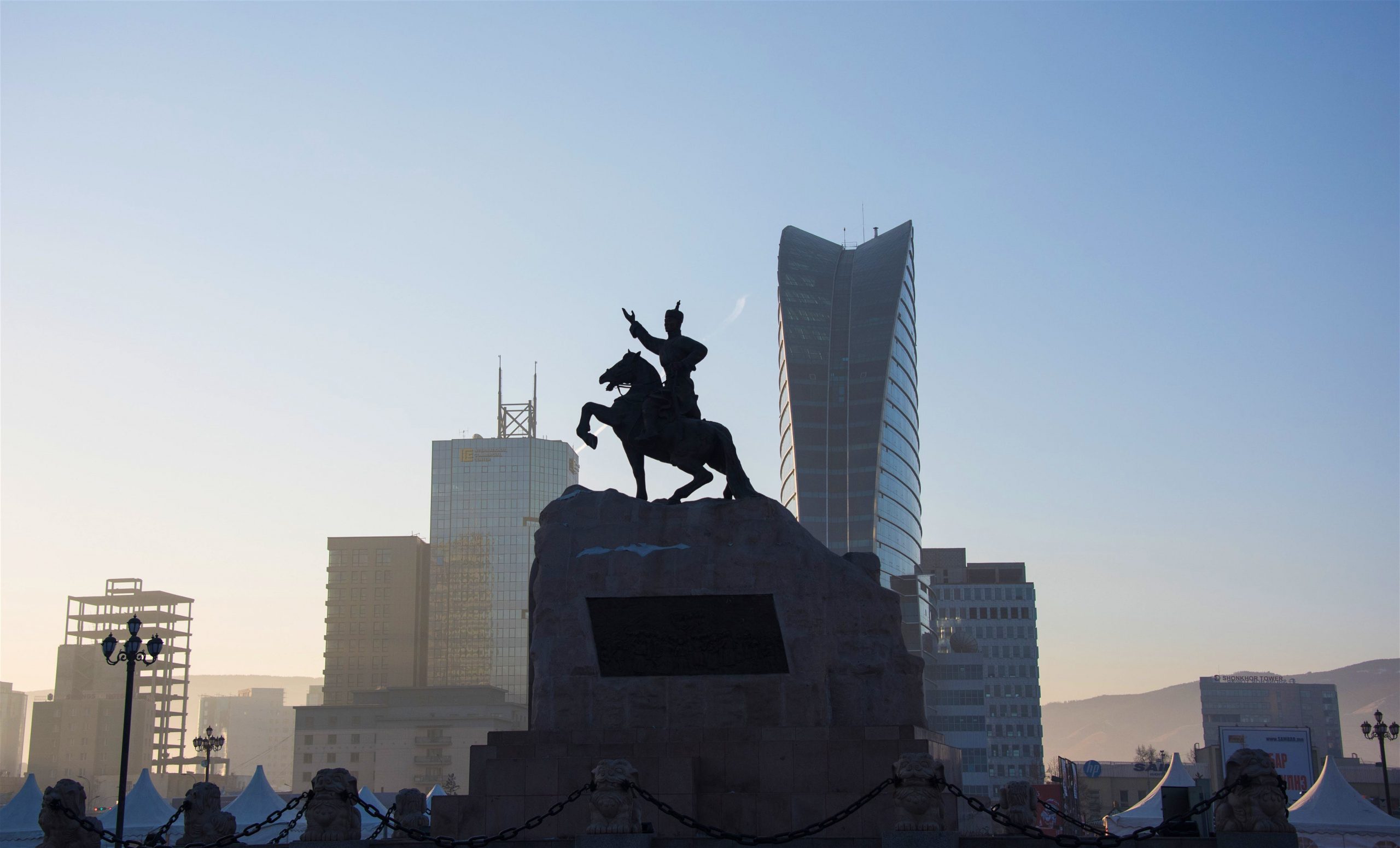
Arrival at Ulan Bator and transfer to your hotel for a warm shower and a moment to relax after this long flight.
Afternoon, visit of Gandantegchinlin Monastery. Built in 1809, the Gandantegchinlin Monastery – formerly known as the Gandan Monastery – is a Tibetan-style Buddhist monastery located in Ulan Bator. Its name of Tibetan origin can be translated as “Great site full of Joy”.Several hundred monks currently reside there.
It contains a statue of Megjid-Janraiseg (Bodhisattva Avalokiteshvara – called Chenrezig in Tibetan) by 25 meters high.
The original statue, made of copper, was erected in 1911 and was dismantled in 1937 by Soviet troops (the remains of the statue were subsequently used to make bullets during the siege of Leningrad). 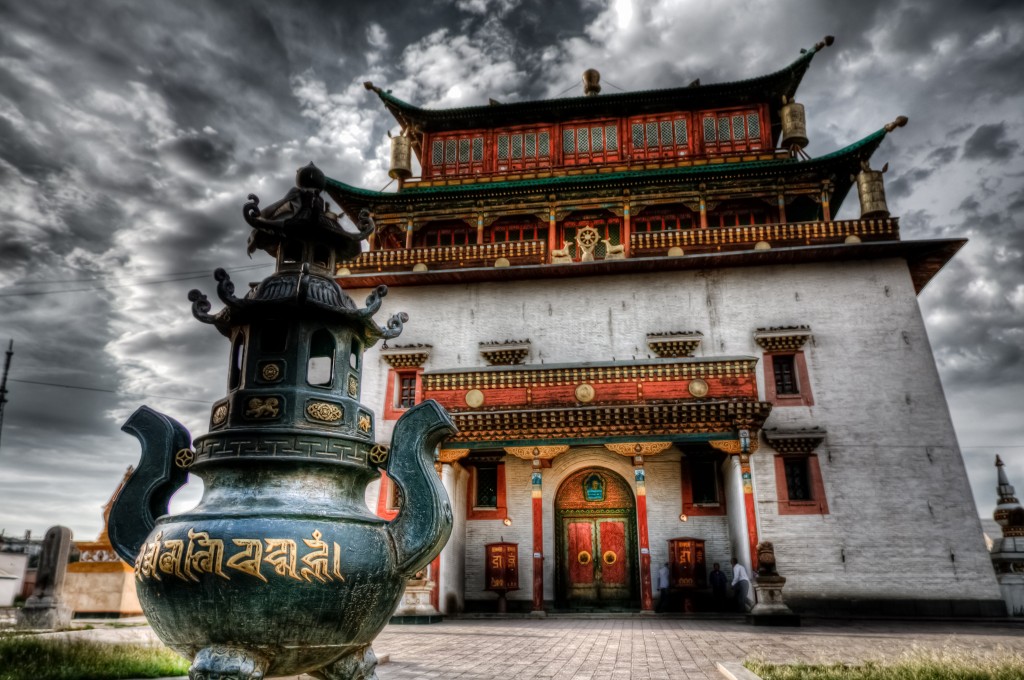 Following the fall of communist regimes, it was rebuilt in 1996 with donations of gold from Nepal and Japan.
Following the fall of communist regimes, it was rebuilt in 1996 with donations of gold from Nepal and Japan.
Adorned with gold and nearly 2,286 precious stones, the statue weighs over 20 tons and is covered with nearly 100 kg of silk clothing.
Visit of the National Museum of Mongolian History. The National Museum of Mongolian History tells the story of the country, from prehistoric times to today. In this museum there is also an ethnographic section with costumes and jewels from various ethnic groups of countries: Kazakhstan, Buriats, Clzemchins…
Dinner and overnight at the hotel.
Day – 2: Ulan Bator – Khogno Khan Park (Bayan Gobi)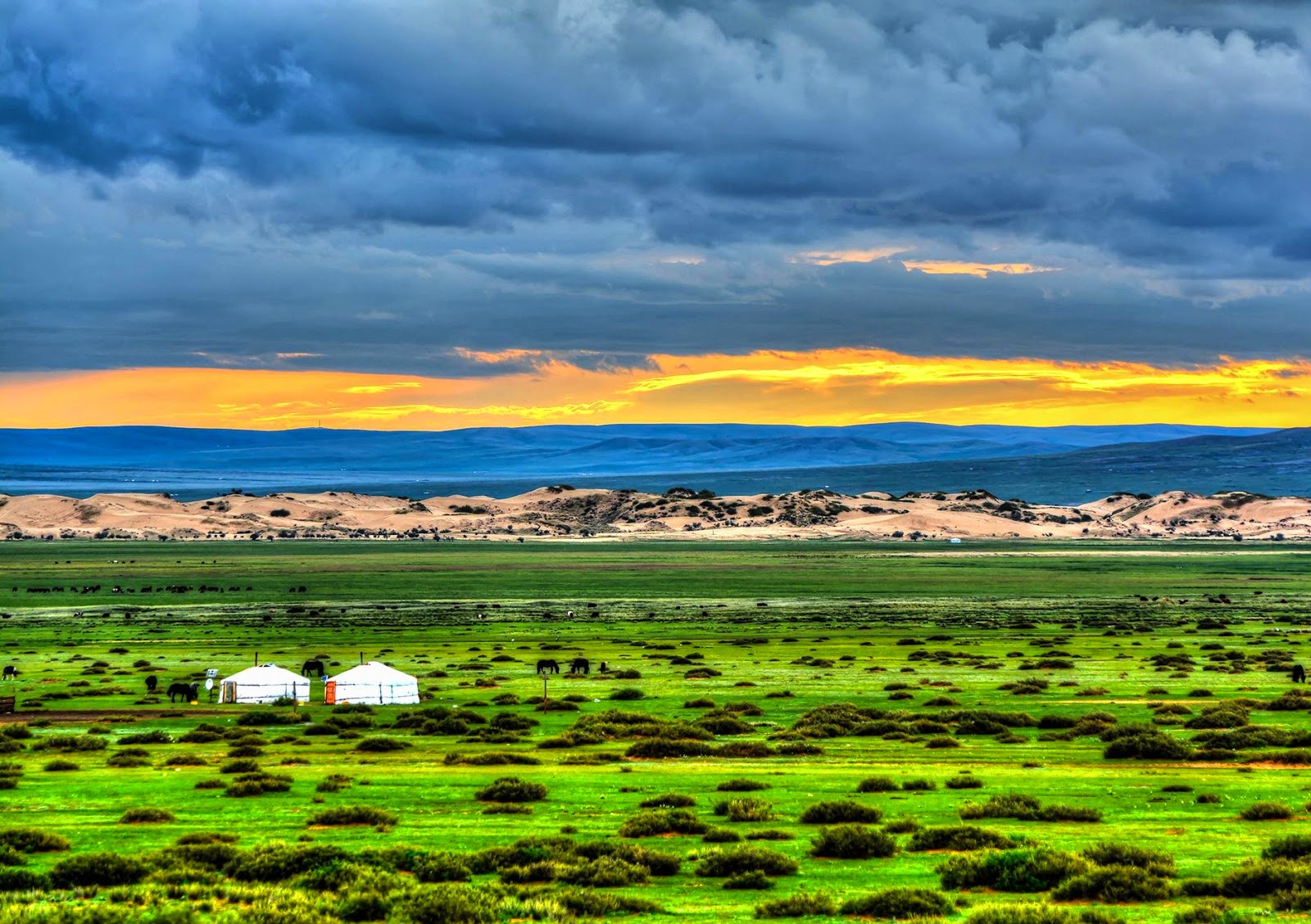
Breakfast and transfer to Hogno Han Park (5 hours drive – strongly depending on the condition of the roads).
Lunch on the way.
Located about 280 km from the capital, Khogno Khan Park will astonish you with its rock formations, cliffs shaped by erosion overlooking vast semi-desert plains irresistibly reminiscent of the citadels sandstone from Wadi Rum in Jordan.
In this spectacular setting, you will discover the Ovgon Khiid Monastery, built during the 17th century.
The park is also home to huge sand dunes offering a variety of stunning landscapes that earned the region its nickname of “Mini Gobi”.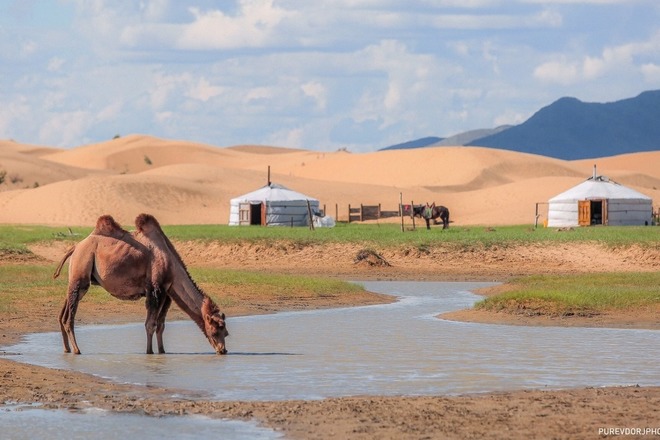
In the afternoon, short first ride in the Mini Gobi.
We will ride to the Ovgon Khiid Monastery, set in a dramatic scenery.
National Park of the Khugnu Tarna is the only opportunity to ride horses in typical Gobi desert landscape, as there are no horses further south in the Gobi Desert.
Dinner and night at the yurt camp (2 to 4 riders per yurt, with single beds, showers in a separate building)
Day – 3: Khogno Khan (Mini-Gobi) – Full day on horseback
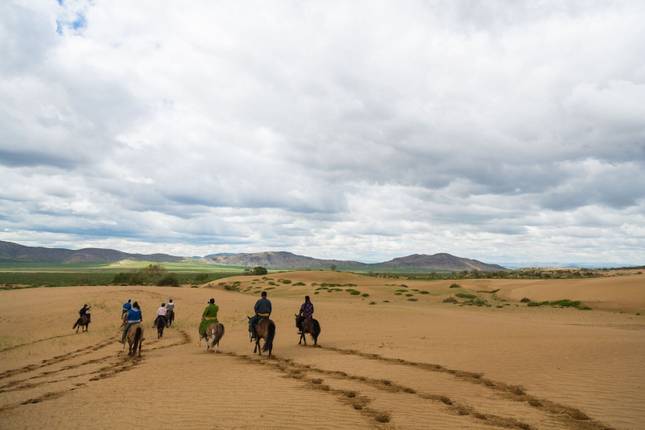
After breakfast, departure for a spectacular day on horseback.
We will ride from the cliffs of the Mini-Gobi, through semi-desert steppes.
At the end of the morning, we reach an area of golden sand dunes called Elsentasarhaï, where our horses will show their remarkable endurance.
Picnic lunch brought by our vehicles, nothing to wear on the horses, so that we can enjoy many gallops!
In the afternoon, we keep on riding in these amazing landscapes.
The contrast between the desert dunes and the marshland that borders them is spectacular!
We pass suddenly from the desert to the Garden of Eden. Nomads often gather their herds in this vast wet plain, a wonderful vision…
We arrive on horseback at the yurt camp, located in a semi-desert environment.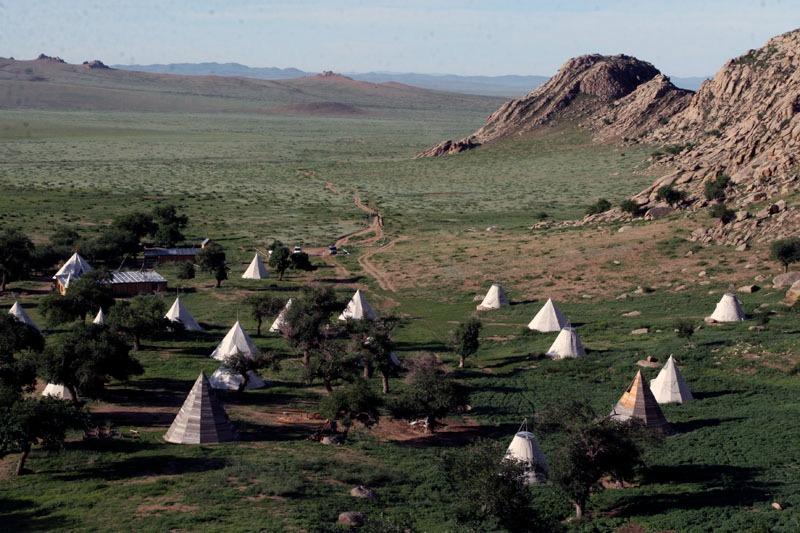
Dinner and night at the yurt camp (2 to 4 riders per yurt, with single beds, showers in a separate building)
Day – 4: Khogno Khan to Orkhon Valley (Khyatruun)
After breakfast, we drive through the Orkhon Valley to visit the family of the nomads who will guide us during this ride and who breed the horses we will ride (4 hours drive – strongly depending on the condition of the roads).
Late lunch, and it is time to choose our horse for the first ride in the Valley.
This short ride will be the opportunity to get acquainted to our horse. As we come back at the nomadic family yurts in the evening, it will be possible to try another horse if necessary.
The rest of the day is devoted to the discovery of the traditional lifestyle of the nomads of Mongolia.
Each yurt camp is home to a family whose daily lives are punctuated by the care of herds: milking mares, sheep, goats and dris (female yaks), caring for sick or debilitated animals, moving animals to new pastures…
Women also take care of children, they cook, prepare different milk products (butter, cheese, fermented mare’s milk, drinking milk …)  and maintain the interior of the yurt.
and maintain the interior of the yurt.
The men look after animals, maintenance of hardware and harness horses. They also cut wood for cooking.
We can participate in these activities, and become acquainted with the various family members.
In the evening, our hosts will prepare a traditional specialty, the Khorkhog, the “Mongolian barbecue”.
The Khorkhog is a traditional nomadic specialty of the Mongolian steppe. You will almost never find it in a restaurant.
To prepare the Khorkhog, nomads cut mutton or goat into piece , keeping the bones. Twenty stones the size of a fist are heated in the fire.
When hot enough, they are placed in layers with the meat in a metal container, which is often a milk can.
Other ingredients are added over the stones and meat, potatoes, carrots, cabbage, seasoning …
Water is added in sufficient quantity for all of the ingredients to be cooked both by the steam and the heat of stones. The container is closed and placed on the fire for an hour to an hour and a half.
At the opening of the container, the Khorkhog is ready to eat.
The family takes out the meat and vegetables, and the stones which turned black, both because of the fire and the fat that they have absorbed.
These stones are still warm and the guests keep them in their hands because Mongols consider them as beneficial to health.

We usually eat the Khorkhog with fingers, with the help of a knife to cut the meat.
This night, we will sleep in a “guest-yurt” close to our nomad family’s yurts.
The comfort is more simple than in the yurt camps as there are no showers, but you will experience the real nomadic way of life…
Day – 5: Horse riding tour in the Orkhon Valley (upstream)
After breakfast with our nomadic family, we start our horse riding adventure in Mongolia.
We ride in the upstream part of the Valley where the landscape becomes wilder and wilder.
This volcanic region has black ancient lava flows which contrast with the white running water of the Orkhon River.
Picnic lunch brought by our vehicules, nothing to carry on the horses, so we can enjoy many canters!
On horseback, we reach the forest with the impressive Naiman Nuur mountains in front of us.
Dinner and night at a very remote yurt camp in the forest (2 to 4 riders per yurt, with single beds, showers in a separate building).
Day – 6: Horse riding tour in the Orkhon Valley (Orkhon Falls)
After breakfast, we still ride in the upstream part of the Valley, returning towards the Orkhon Falls through another way.
Picnic lunch brought by our vehicles, nothing to wear on the horses, so that we can enjoy many gallops!
We arrive in the afternoon at our ger camp, not far from the famous Orkhon Falls where we go on horseback.
The Orkhon Falls are actually the Ulaan Tsutgalan River Falls. The river falls into a spectacular canyon formed after an earthquake and a volcanic eruption more than 20 000 years ago, forming a cascade of 20 meters high and 10 meters wide.
The site is enchanted by the contrast between the whiteness of the foam and the black rock that forms the canyon walls. Going down along the walls to the foot of the fall, you will discover trees and flowers (wild peonies) that take advantage of the abundance of water to grow.
Dinner and night at the yurt camp (2 to 4 riders per yurt, with single beds, showers in a separate building).
Day – 7: Horse riding tour in the Orkhon Valley (Uurt)
Another beautiful day on horseback as we will ride to one of the most famous sites of the Orkhon Valley: Uurt Canyon.
Picnic lunch brought by our vehicles, nothing to wear on the horses, so that we can enjoy many gallops!
We are now in the downstream section of the Valley, the landscapes are more open, towered by two mountain ranges, and we meet lots of nomadic families with their herds, who take advantage of the rich grass of the valley.
The arrival at the yurt camp (gercamp) is a nice surprise as it is located in a superb site, bordering the canyon of the Orkhon River. We will spend 2 nights in this beautiful gercamp.
Dinner and night at the yurt camp (2 to 4 riders per yurt, with single beds, showers in a separate building)
Day – 8: Horse riding tour in the Orkhon Valley (Around Uurt)
Today we ride in the surrounding mountains, to get a higher view on the Orkhon Valley.
We return to the same gercamp in the evening.
Dinner and night at the yurt camp (2 to 4 riders per yurt, with single beds, showers in a separate building).
Day – 9: Horse riding tour in the Orkhon Valley (Khujirt)
Today we ride on the southern mountains bordering the Orkhon Valley, in Khujirt region.
Khujirt is famous for its water, which is bottled and sent all over Mongolia.
The view is spectacular on the river which is now mich wider and lazy among wavy grassy hills.
That’s the Mongolia of your dreams …
Picnic lunch brought by our vehicles, nothing to wear on the horses, so that we can enjoy many gallops!
We arrive in the afternoon at a unique environment friendly yurt camp.
The view from the camp on the huge valley is incredible.
This camp is “eco-friendly”, there is no “real” showers, but wet towels at our disposal: quite surprising but efficient!
Dinner and night at the yurt camp (2 to 4 riders per yurt, with single beds, showers in a separate building).
Day – 10: Horse riding tour in the Orkhon Valley (Karakorum)
Today is our last day on horseback in the Orkhon Valley.
In the last miles before Karakorum – the former capital of Mongolian Empire – the Valley is narrower, offering wonderful views from  the mountain slopes on the Orkhon river.
the mountain slopes on the Orkhon river.
This part of the Orkhon Valley is one of the nicest, as the river is very calm, the water reflecting the sky as a mirror. The dark blue water contrasts with the lush green of the grass, and the white yurts around. Many herds roam in the steppe around, and you will take many pictures of the typical Mongolia today.
It is time to say good bye to our horses and to our wonderful nomadic friends.
Dinner and night at the yurt camp (2 to 4 riders per yurt, with single beds, showers in a separate building).
Day – 11: Karakorum – Hustai National Park
After breakfast, we visit Erdene Zuu Monastery.
Karakorum (Kharkhorin) is the ancient capital of the Mongol Empire, founded in 1235 by Ogödei, the son of Genghis Khan.
In 1260, Kublai Khan transfers the capital to Beijing. Karakorum was destroyed in 1388 by troops of the Ming Dynasty. Of its former glory remain mere turtle statues guarding the entrances to the city walls.
In 1585, the Erdene Zuu has been built just outside the walls of the ruins of the ancient capital after the introduction of Buddhism in Mongolia as the state religion. Stones from the ruins of Karakorum were used in the construction.
It is surrounded by a wall with 108 stupas. 108 is a sacred number in Buddhism, and it is also the number of beads in a Buddhist rosary (mala).
The monastery was damaged in the 1680s, but was rebuilt in the eighteenth century and in 1872.
For centuries, Erdene Zuu was the most important religious shrine in Mongolia.
In 1939 the communist leader Horloogiyn Choybalsan destroyed the monastery, in a purge that resulted in the disappearance of hundreds of monasteries in Mongolia and killed over ten thousand monks.
Three small temples and the outer wall with the stupas remained; the temples became museums in 1947.
After the fall of communism in Mongolia in 1990, the monastery was given to lamas and Erdene Zuu again became a place of worship.
The site was restored at the end of the century and regained part of its religious aspect. Today Erdene Zuu remains an active Buddhist monastery as well as a museum that is open to tourists.
After the visit, we drive to Hustai National Park (4 hours drive – strongly depending on the condition of the roads).
Declared Biosphere Reserve by UNESCO in 2002, the Hustai National Park covers 50 000 hectares of steppe and mountain forest and is home to many species of mammals and birds.
It is best known for hosting the conservation project to protect the endangered Takhi. This wild horse, also known as Przewalski’s horse, had completely disappeared from its natural habitat. Only a few specimens were still present in zoos around the world.
 A breeding and reintroduction program was initiated in 1992, resulting in a wild and sustainable Takhi population inside the Khustai park which now stands at about 260 individuals.
A breeding and reintroduction program was initiated in 1992, resulting in a wild and sustainable Takhi population inside the Khustai park which now stands at about 260 individuals.
To observe the Takhi, it is best to travel by vehicle to the banks of rivers where they come to drink early in the morning and evening. The rest of the day, they disperse into the mountains in search for food.
In the afternoon, we go on a drive in the Park to try and find the Takhi.
Dinner and night at the yurt camp (2 to 4 riders per yurt, with single beds, showers in a separate building).
Day – 12: Hustai – Ulan Bator
Breakfast and early departure to Ulan Bator (2,5 hours drive – strongly depending on the condition of the roads).
Lunch and free time for shopping in stores downtown.
In the late afternoon, you will attend a show with traditional dances, music and songs from Mongolia, especially the amazing Khoomei.
The Khoomei is an overtone singing (throat singing) in which the singer produces two distinctively audible pitches at the same time, including a low pedal note, or drone, derived from the fundamental frequency of the vocal cord vibrations, and higher melodic notes that result when the singer’s mouth acts as a filter, selecting one note at a time from among the drone’s natural overtone series pitches.
The sound is reminiscent of the Jew’s harp.
This type of song is recorded in Intangible Cultural Heritage of Humanity by UNESCO in 2010.
Dinner downtown and overnight at a 3* hotel.
Day – 13: Return Home
Breakfast (depending on your flight schedule) and transfer to airport for your flight back home.
No lunch included as most flights depart in the morning.
INCLUDED
- Airport / hotel / airport transfers
- 2 nights in a ** hotel in Ulaanbaatar, breakfast included
- Full board during the excursion
- Meal at Ulan Bator
- Mineral water
- 9 nights in a comfortable yurt camp with hot shower
- 1 nights homestay, in guest yurt
- Travel in 4×4 or mini bus + driver
- Gasoline
- English speaking guide
- Cook for groups> 4 participants
- Horse riding
- Horse rental + 1 additional horse for 3 or 4 people in case of bad understanding with your horse or injury
- Local horse guides
- Equestrian equipment with Kazakh or English riding saddles
- Grooms
- Entrance fees to the parks and museums mentioned
- Traditional show
- IRIDIUM satellite phone
- Kitchen equipment (mess tent, camping tables and chairs) and for sleeping (tent, sleeping bag, ground mattress), sanitary tent
NOT INCLUDED
- International transport
- Passport & Visa Fees
- Repatriation insurance
- Travel insurance
- Extra drinks / alcohols
- Phone calls
- Any excursion not mentioned in the program






